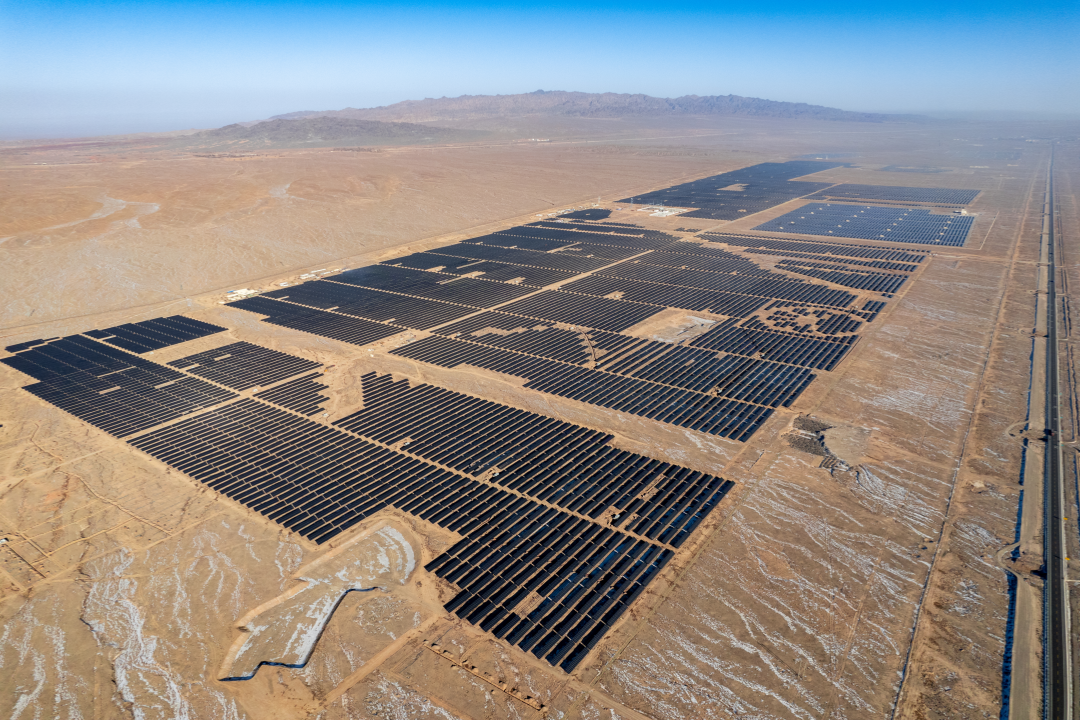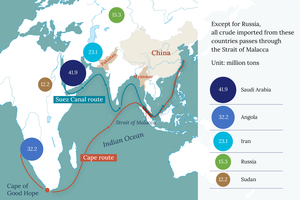Energy Insider: China Could Double Wind and Solar Capacity Goal By 2030, Solar Panel Manufacturers Warn of ‘Interim Overcapacity’
Listen to the full version

In this week’s Caixin energy wrap, we analyze China’s biggest climate and energy news on policy, industry, projects and more:
● China wind and solar capacity may double target
● Solar manufacturers warn of ‘interim overcapacity’
● Beijing lowers new-energy utilization rate
● Number of hydrogen-fueled vehicles expected to soar
● Planes powered by domestic biofuel take off

Download our app to receive breaking news alerts and read the news on the go.
Get our weekly free Must-Read newsletter.
- DIGEST HUB
- China's wind and solar power capacity is projected to reach at least 2,200 GW by 2030, potentially doubling its target of 1,200 GW.
- Solar manufacturers warn of "interim overcapacity," while policies have lowered new energy utilization rate targets to no less than 90%.
- China is advancing hydrogen fuel-cell vehicles, targeting over 1 million by 2035, and biofuel-powered planes mark progress in green aviation technologies.
This week's Caixin energy wrap highlights China's significant developments in the energy sector, including policy updates, industry insights, major projects, and technological advancements [para. 1]. Key topics covered are:
1. **Potential Doubling of Wind and Solar Capacity by 2030**: An energy expert, Huang Zhen, announced China’s cumulative wind and solar power capacity is expected to reach at least 2,200 gigawatts (GW) by 2030, potentially hitting 2,400 GW [para. 3]. This forecast nearly doubles the government's target of installing over 1,200 GW by 2030, showing a projected fourfold increase from 530 GW in 2020 [para. 3]. The International Energy Agency (IEA) corroborated this optimistic outlook, predicting that China would achieve its 1,200 GW goal by 2024, years ahead of schedule [para. 3].
2. **Interim Overcapacity in Solar Manufacturing**: At an industry conference, Chinese solar manufacturing executives cautioned about an "interim overcapacity" [para. 5]. Li Gang, chairman of Seraphim Energy, noted that China’s solar module manufacturing capacity has reached approximately 861 GW, enough to replicate two decades of work in just nine months if fully utilized [para. 5]. Despite these warnings, officials like Ding Xiufeng from Inner Mongolia argued that the demand from developing countries justifies further expansion [para. 5].
3. **Reduction in New-Energy Utilization Targets**: China lowered the renewable power utilization rate for provincial governments from 95% to 90%, due to the grid's difficulty in absorbing the burgeoning wind and solar energy output [para. 7]. Zheng Ying from Tsinghua University suggested that maintaining the higher target would necessitate expensive energy storage facilities, weakening the competitiveness of renewable energy [para. 7]. Last December, China’s renewable power capacity exceeded that of thermal power for the first time [para. 7].
4. **Growth in Hydrogen-Fueled Vehicles**: Ouyang Minggao from Tsinghua University projected that China could have more than 1 million fuel-cell vehicles on the road by 2035 [para. 9]. This year nearly 10,000 fuel-cell vehicles are expected to be sold, with figures rising to over 50,000 by 2025 [para. 9]. Key advancements in vehicle parameters include improved power output, efficiency, longevity, and nearly halved production costs [para. 9]. However, high production costs remain a constraint, as evidenced by their current market share of just 0.06% amongst new-energy vehicles sold in 2023 [para. 9].
5. **Biofuel-Powered Flights**: China has made a notable advancement in green aviation with test flights of two planes powered partly by biofuel derived from "gutter oil" [para. 11]. The biofuel, produced by China Petroleum & Chemical Corp (Sinopec), was mixed with conventional aviation fuel in a 40:60 ratio [para. 11]. This effort contributes to China’s strategy to decarbonize its aviation industry, which is responsible for roughly 1% of national carbon emissions, highlighting an important breakthrough in incorporating domestically developed planes and biofuel [para. 11].
In conclusion, these highlights from Caixin underscore China’s ambitious strides and ongoing challenges in achieving sustainable energy growth, making significant advancements in renewables, hydrogen fuel technology, and green aviation. The developments indicate a strong push toward meeting, if not surpassing, national and global renewable energy targets, while balancing the complexities of market demand and infrastructural capabilities.
- Seraphim Energy
- Seraphim Energy, chaired by Li Gang, is a Jiangsu-based solar module manufacturer. At an industry conference, Li noted that China's combined manufacturing capacity for solar modules has reached about 861 GW, cautioning about "interim overcapacity." He highlighted that this capacity could replicate 20 years' worth of work within just nine months.
- China Petroleum & Chemical Corp.
- China Petroleum & Chemical Corp. (Sinopec) has produced renewable biofuel derived from "gutter oil," which includes cooking oil recycled from restaurants, household drains, and grease traps. Mixed at a 40:60 ratio with conventional aviation fuel, this biofuel powered two planes in test flights. This achievement marks a significant step forward for China in green aviation technologies, supporting efforts to decarbonize its aviation industry.
- Wuhan WUT HyPower Technology Co. Ltd.
- Wuhan WUT HyPower Technology Co. Ltd. specializes in fuel-cell technology. Its general manager, Tian Mingxing, noted that high production costs are currently restricting the promotion of hydrogen fuel-cell vehicles, although key parameters such as power output, efficiency, and lifespan have significantly improved since 2020.
- Last December:
- China’s cumulative renewable power capacity surpassed that of thermal power for the first time, making up more than 50% of the national total.
- As of April 2024:
- China’s total wind and solar capacity already stood at 1,130 GW, according to the International Energy Agency (IEA).
- Earlier this month (June 2024):
- The International Energy Agency (IEA) published a report stating that China will hit its 1,200 GW wind and solar goal in 2024, six years ahead of schedule.
- June 4, 2024:
- China's National Energy Administration (NEA) released a new notice lowering the new-energy utilization rate target for provincial governments in resource-abundant areas to no less than 90%, a drop of five percentage points.
- June 5, 2024:
- Ouyang Minggao stated at an industry seminar that China could have more than 1 million fuel-cell vehicles on the road by 2035.
- June 5, 2024:
- Two planes partially powered by biofuel took off from Shanghai Pudong International Airport and Shandong Dongying Airport and completed test flights before returning to their respective airports.
- June 11, 2024:
- Huang Zhen, an energy expert, predicted at a solar power conference in Shanghai that China’s cumulative wind and solar power capacity will reach at least 2,200 GW by 2030 and is very likely to reach 2,400 GW by that year.
- GALLERY
- PODCAST
- MOST POPULAR







 Sign in with Google
Sign in with Google
 Sign in with Facebook
Sign in with Facebook
 Sign in with 财新
Sign in with 财新